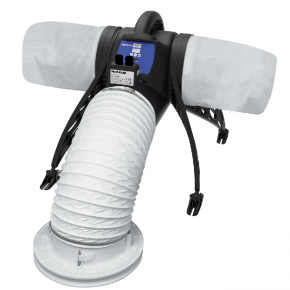
Energy efficient heat pumps are becoming popular as fuel prices soar
A domestic heat pump typically generates flow temperatures of between 35 and 50°C
For the non-technical enthusiast, heat pumps seem almost too good to be true. You take the background temperature of the air or the ground and amplify it with your heat pump to warm your house. The best analogy for the layman is a fridge, which sucks the heat energy out of the food stored within and radiates it to the environment via that black metal grille at the back.
It’s hard to imagine that there’s any heat stored in a litre of milk, let alone the chilly air or soil outside your house. And it is true that the kind of heat pump used for heating buildings will not produce temperatures anywhere near those obtained from your oil- or gas-fired central heating boiler.
A domestic heat pump typically generates flow temperatures (the temperature of the water being circulated) of between 35 and 50°C. This is significantly lower than the flow temperature produced by a domestic gas or oil-fired boiler which is generally in the region of 60-70°C. But when combined with a wet (as opposed to electrical) underfloor heating (UFH) system, a heat pump will transfer more of this heat energy to the occupants of the building and do it more efficiently than a traditional heating system.
As a UFH system heats the entire floor, it does not need to reach the high temperatures of a wall-mounted radiator which has to concentrate the heat in a much smaller area. A further, practical advantage of UFH, is the fact that it occupies no wall space and is effectively invisible.
Ten years ago, most UFH systems were electrical. At the time, this was (and still is) one of the most efficient ways of using electricity for domestic heating. A well-insulated floor slab will act as a highly effective storage heater, requiring only a low-level of heat to maintain a comfortable temperature.
However, for the optimum low-carbon heating option, a wet UFH system, running off a heat pump wins hands down. A little electricity is required to operate the pump, but the inherent efficiency of the system means that for every 1kW of power consumed by the system, you extract 3-4kW of heat energy from the low-level background temperature.
The efficiency of a UFH/heat pump system can be further enhanced if electricity is generated locally for example, from roof-mounted solar panels to power the pump.
With the price of fossil fuels becoming ever more volatile and Building Regulations clamping down on carbon emissions, a low-energy heating system combining a heat pump and wet UFH is almost impossible to beat for efficiency, comfort and value.
Latest news

13th March 2025
Vent-Axia Publishes Free eBook to Help Social Housing Landlords Navigate Awaab’s Law
Leading British ventilation manufacturer Vent-Axia has published a free eBook, ‘Ensuring Safe Housing Conditions: Focusing on Mould and Damp Conditions’.
Posted in Air Conditioning, Articles, Building Industry News, Building Products & Structures, Building Regulations & Accreditations, Building Services, Damp & Waterproofing, Facility Management & Building Services, Health & Safety, Heating, Ventilation and Air Conditioning - HVAC, Innovations & New Products, Publications, Research & Materials Testing, Retrofit & Renovation
13th March 2025
First Processing Industries apprenticeship completed within West Fraser
West Fraser is pleased to announce that the company’s continued investment in apprenticeships, as well as wider staff development training, has seen one recruit successfully complete his modern apprenticeship.
Posted in Articles, Building Industry Events, Building Industry News, Building Products & Structures, Building Regulations & Accreditations, Building Systems, Recruitment, Restoration & Refurbishment, Retrofit & Renovation, Timber Buildings and Timber Products, Training, Walls, Wooden products
11th March 2025
ADSA’s 40 Years of Innovation
The Automatic Door Suppliers Association (ADSA) is kicking off its 40th anniversary with the launch of an animated timeline that showcases its incredible journey and industry-defining achievements.
Posted in Access Control & Door Entry Systems, Architectural Ironmongery, Articles, Building Associations & Institutes, Building Industry Events, Building Industry News, Building Products & Structures, Building Services, Doors, Facility Management & Building Services, Health & Safety, Innovations & New Products, Recruitment, Retrofit & Renovation, Security and Fire Protection, Training, Videos
11th March 2025
Senior answers the call at Merseyside’s new state-of-the-art fire station
Safe, secure, and sustainable aluminium fenestration solutions from Senior Architectural Systems have been installed at Merseyside Fire & Rescue Service’s brand-new fire station in Aintree.
Posted in Aluminium Products, Articles, Building Industry News, Building Products & Structures, Building Systems, Case Studies, Curtain Walling, Doors, Facades, Glass, Glazing, Restoration & Refurbishment, Retrofit & Renovation, Sustainability & Energy Efficiency, Walls, Windows
 Sign up:
Sign up: